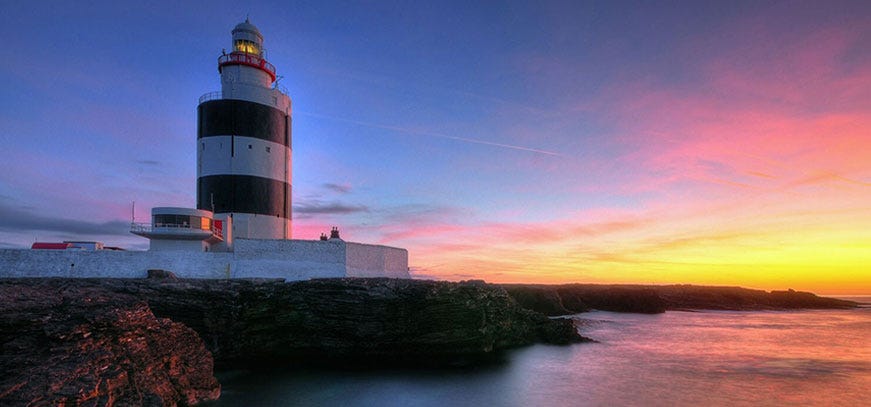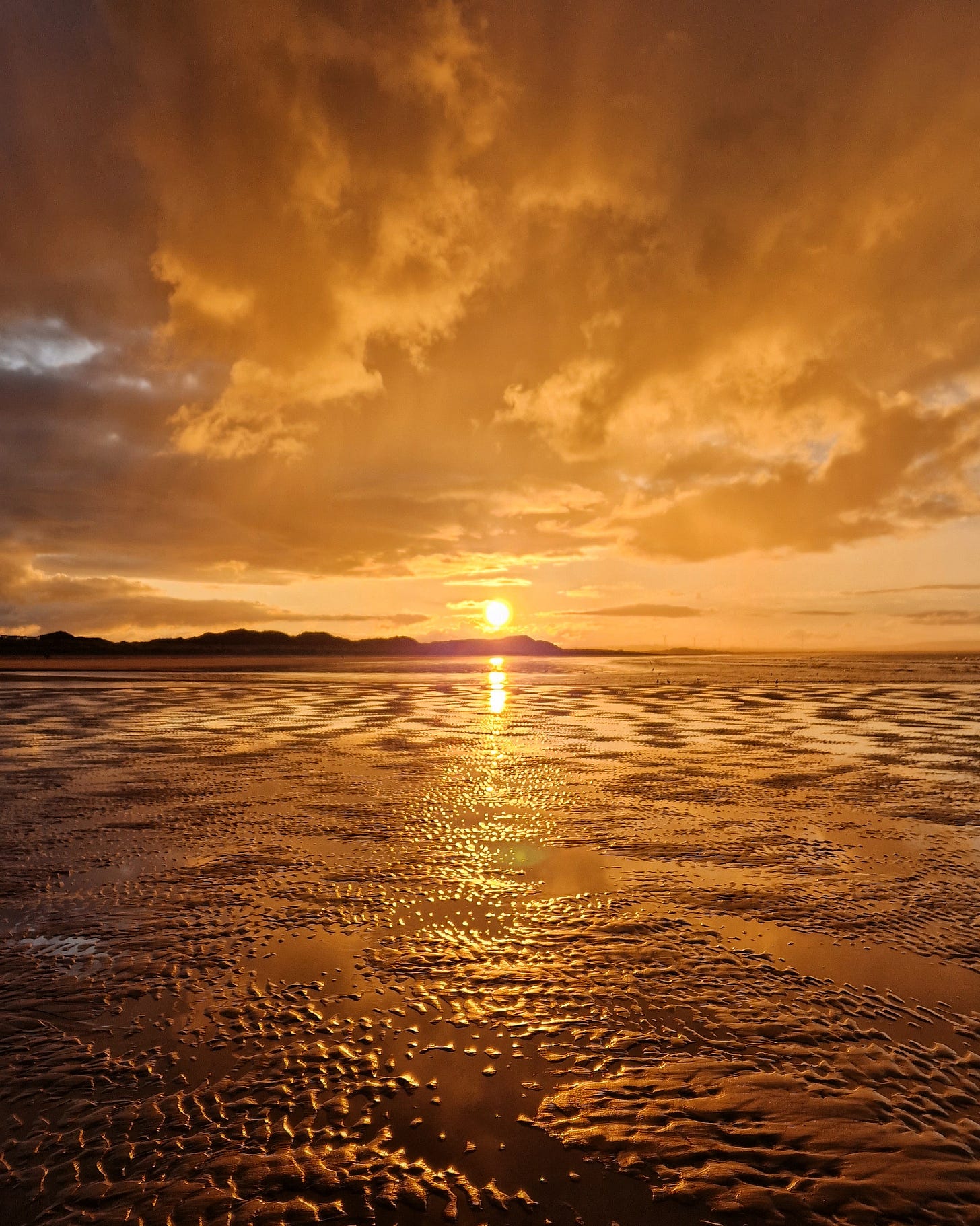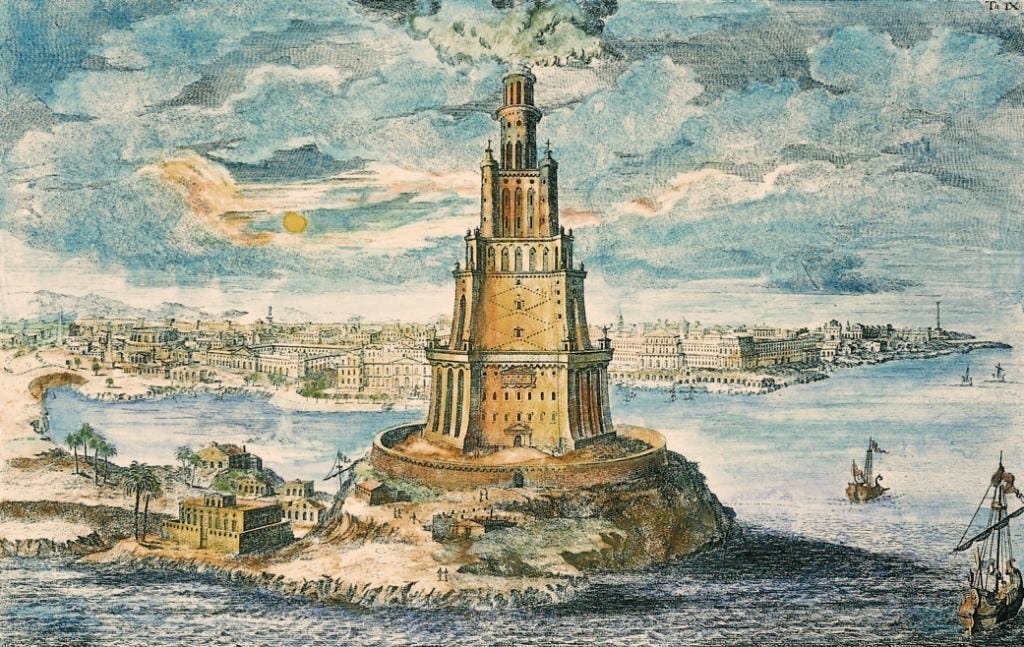Beacons
of light and hope in the darkness
Dear word explorer,
We approach the summer solstice in Ireland with a prediction of beautiful weather, which is a gorgeous synchronicity. I’ve experienced the dawn of many leaden and damp solstices in this rain-soaked island.
I did a quick query of my Flickr archive (which stretches back to 2006) and I notice I placed far more primacy upon capturing the winter solstice dawns or sunsets. Of course they represent hope in the darkness, which is a more vital concern during our extended winter nights.
At the moment we are flooded with light much of the time… so much so that my brain is desperately forcing me to bed when the few hours of true darkness descend.
The above photo was taken on a beach during October, yet it demonstrates that suffusion of golden warmth during the memorable days of summer. For those of you feeling the weight of world events heavy upon your heart, I hope it offers a reminder that nature can provide a solace (even if it’s an outing to your local park or a patch of wilderness).
Today I wanted to offer a brief tour on the subject of lighthouses, thanks to a recent research rabbit hole.
It’s easy to imagine that lighthouses were a more recent invention, considering the difficulty presented with building them in places that are often wild and inaccessible. But the history of lighthouses allows us to appreciate the utter ingenuity of our ancestors. They built so many structures that we consider part of the realm of fantasy, but they were simply the result of remarkable design based upon diligent study and hard labour.
The oldest recorded lighthouse was the Pharos of Alexandria, also known as the Lighthouse of Alexandria, which was was built on the little island of Pharos, just off the coast of Alexandria, Egypt.
It was completed around 280 BCE during the reign of Ptolemy II Philadelphus, but it had been commissioned by his father, Ptolemy I Soter, one of Alexander the Great’s generals, and the founder of the Ptolemaic dynasty. The architect most often credited for the edifice is Sostratus of Cnidus, but we know little about the army of stonemasons who brought the idea into realisation. It became an emblem of power and civilisation, and appeared on coins minted in Alexandria during the Roman period. They provide some of the earliest representations of the lighthouse and are valuable historical artifacts for both numismatists1 and historians.
The lighthouse was constructed to guide ships into the busy harbour of Alexandria, which was a major hub of commerce and culture for hundreds of years. Its strategic location made it vital for maritime navigation, especially due to dangerous reefs in the area.
Imagine the impression this made upon people as they sailed into this famous port!
It’s been estimated that it was at least 100 meters high (perhaps more), making it the tallest structure of the era, second only to the Great Pyramid of Giza. The light from the pyre which burned at the top was enhanced and projected out to sea by a giant polished bronze mirror. The beacon could reportedly be seen up to 60–100 km away.
It is considered one of the Seven Wonders of the World due to its scale, engineering, and importance. Devastating earthquakes from the 10th - 14th centuries levelled the structure, and by 1480, the remaining stones were repurposed to build the Citadel of Qaitbay on the same site.

Ireland has a long history of lighthouses since it is an island country with many inlets that can be treacherous to navigate.
Hook Lighthouse, located at the tip of the Hook Peninsula in New Ross, County Wexford, is one of the oldest operational lighthouses in the world. According to tradition, the first beacon on Hook Head was established by St. Dubhán, a Welsh monk, in the 5th century. Monks from his monastery tended warning fires to alert sailors of the hazardous rocks.
In 1201, William Marshal, Earl of Pembroke (c. 1146/1147 – 14 May 1219), a powerful Anglo-Norman lord called ‘the Marshal’ ordered the construction of the lighthouse (it was completed around 1240). He was a renowned knight and statesmen of medieval occupied Ireland, and served five English kings: Henry II, his son Young Henry, Richard I, John, and Henry III.
Let’s just say he wasn’t local to the area…
Marshal married Isabel de Clare (c. 1172 – 11 March 1220) who was one of the wealthiest noblewomen of medieval Britain and Ireland. As the child of Richard de Clare, known as ‘Strongbow’, and Aoife of Leinster, Isabel owned massive estates in England, Wales, and Ireland, making her a powerful woman of the era.
Isabel had become heiress after her only brother Gilbert died circa 1185, so she inherited the family’s vast lands and titles. King Richard I made her his royal ward, which gave him the ‘right’ to grant her hand in marriage to any of his powerful lords. At the time, inheritance rights for women were shaped by a combination of customary law, feudal practices, and statutes, but once she was his ward Isabel had little say in the matter, especially as she was ‘under protection’ in the Tower of London.2
Isabel and Marshal’s marriage appears to have been a happy one, or at least it was productive since they had ten children together: five sons and five daughters.
The power couple constructed many churches and monasteries in the area, and established the town of New Ross for its strategic location on the River Barrow. Their vision was to establish a flourishing trade centre that would serve their estates in the valleys upriver, and to rival the existing port at Waterford.
The lighthouse was required to guide the fleets of ships to New Ross and cement their power base in the country. The monks continued to maintain the beacon until the Protestant Reformation and the dissolution of the monasteries in the 16th century — events which had a grievous impact upon Ireland.
If you are interested in the subject, I highly recommend the two seasons of the stunning RTÉ documentary, Great Lighthouses of Ireland. Season one is available on Amazon Prime.
This series tells the fascinating story of Ireland's lighthouses and their continuing importance in modern Irish life. Visually spectacular the series features stunning footage of Ireland's lighthouses and reveals how Ireland became a world leader in lighthouse engineering.
Oceans and seas cover about 70–71% of the Earth's surface, and their great tempests remind us of our minority position quite regularly. Our lighthouses are important beacons in the night, guiding sailors across dark waters and back to their safe havens.
It reminds me that I wrote a short story ‘Oathkeeper’, which featured a fictional lighthouse off Northern Ireland, which appeared in Great British Horror 4: Dark and Stormy Nights, edited by Steve Shaw, and published by Black Shuck Books.
Every year Steve invites an international writer to contribute to the volume, so I was honoured to be among such a wealth of British talent.
Numismatists doesn’t just mean coin-collectors, but refers to people who are interested in the historical, artistic, and social context of money, and they research how, when, and why coins and currency were made and used. It comes from the French numismatiste (first recorded in 1788), which derives from the Latin numismat-, the stem of numisma meaning ‘current coin’ or ‘coinage.’
Primogeniture (the right of the eldest son to inherit all or most of his father's estate) became the dominant system in England (and later, Ireland) after it was codified in English law with the Statute of Westminster II (De Donis Conditionalibus) in 1285. Primogeniture for the British throne (male-preference) was abolished by the Succession to the Crown Act 2013, and came into effect in 2015. This means that for the monarchy, absolute primogeniture (the eldest child inherits) is now the law. But, for hereditary peerages and and other noble titles, male primogeniture is in effect in almost all cases. Titles pass to the eldest son or next male heir, and daughters are regularly excluded from their inheritance unless the original title allows otherwise. It remains in practice today despite calls for reform.







What a fascinating article! I love lighthouses. I’m an amateur photographer and I’ve always wanted to take photos of lighthouses (I even went through a phase of wanting, more than anything, to live in one). Sadly, South Korea doesn’t have many iconic ones that are not surrounded by colour-changing LEDs and overly cute mascots, making them less than ideal subjects for the kind of images I’d like to produce.
Not sure how I missed this Maura. Enjoyed the history lesson. Will watch that documentary.